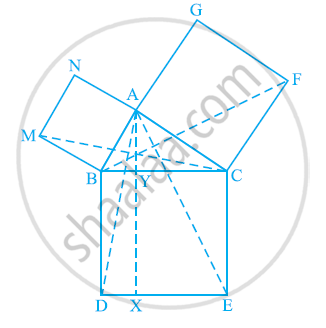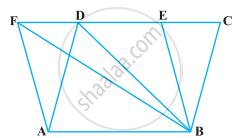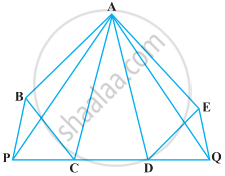Advertisements
Advertisements
प्रश्न
D, E and F are respectively the mid-points of the sides BC, CA and AB of a ΔABC. Show that
(i) BDEF is a parallelogram.
(ii) ar (DEF) = 1/4ar (ABC)
(iii) ar (BDEF) = 1/2ar (ABC)
उत्तर

(i) In ΔABC,
E and F are the mid-points of side AC and AB respectively.
Therefore, EF || BC and EF = 1/2BC (Mid-point theorem)
However, BD = 1/2BC (D is the mid-point of BC)
Therefore, BD = EF and BD || EF
Therefore, BDEF is a parallelogram.
(ii) Using the result obtained above, it can be said that quadrilaterals BDEF, DCEF, AFDE are parallelograms.
We know that diagonal of a parallelogram divides it into two triangles of equal area.
∴Area (ΔBFD) = Area (ΔDEF) (For parallelogram BD)
Area (ΔCDE) = Area (ΔDEF) (For parallelogram DCEF)
Area (ΔAFE) = Area (ΔDEF) (For parallelogram AFDE)
∴Area (ΔAFE) = Area (ΔBFD) = Area (ΔCDE) = Area (ΔDEF)
Also,
Area (ΔAFE) + Area (ΔBDF) + Area (ΔCDE) + Area (ΔDEF) = Area (ΔABC)
⇒ Area (ΔDEF) + Area (ΔDEF) + Area (ΔDEF) + Area (ΔDEF) = Area (ΔABC)
⇒ 4 Area (ΔDEF) = Area (ΔABC)
⇒ Area (ΔDEF) = 1/4Area (ΔABC)
(iii) Area (parallelogram BDEF) = Area (ΔDEF) + Area (ΔBDF)
⇒ Area (parallelogram BDEF) = Area (ΔDEF) + Area (ΔDEF)
⇒ Area (parallelogram BDEF) = 2 Area (ΔDEF)
⇒ Area (parallelogram BDEF)`= 2xx1/4"Area "(ΔABC)`
⇒ Area (parallelogram BDEF) = 1/2Area (ΔABC)
APPEARS IN
संबंधित प्रश्न
In the given figure, diagonals AC and BD of quadrilateral ABCD intersect at O such that OB = OD. If AB = CD, then show that:
(i) ar (DOC) = ar (AOB)
(ii) ar (DCB) = ar (ACB)
(iii) DA || CB or ABCD is a parallelogram.
[Hint: From D and B, draw perpendiculars to AC.]

ABCD is a trapezium with AB || DC. A line parallel to AC intersects AB at X and BC at Y. Prove that ar (ADX) = ar (ACY).
[Hint: Join CX.]
In the following figure, ABC and BDE are two equilateral triangles such that D is the mid-point of BC. If AE intersects BC at F, show that

(i) ar (BDE) = 1/4 ar (ABC)
(ii) ar (BDE) = 1/2 ar (BAE)
(iii) ar (ABC) = 2 ar (BEC)
(iv) ar (BFE) = ar (AFD)
(v) ar (BFE) = 2 ar (FED)
(vi) ar (FED) = 1/8 ar (AFC)
[Hint : Join EC and AD. Show that BE || AC and DE || AB, etc.]
Diagonals AC and BD of a quadrilateral ABCD intersect each other at P. Show that ar (APB) × ar (CPD) = ar (APD) × ar (BPC).
[Hint : From A and C, draw perpendiculars to BD.]
In the following figure, ABC is a right triangle right angled at A. BCED, ACFG and ABMN are squares on the sides BC, CA and AB respectively. Line segment AX ⊥ DE meets BC at Y. Show that:-

(i) ΔMBC ≅ ΔABD
(ii) ar (BYXD) = 2 ar(MBC)
(iii) ar (BYXD) = ar(ABMN)
(iv) ΔFCB ≅ ΔACE
(v) ar(CYXE) = 2 ar(FCB)
(vi) ar (CYXE) = ar(ACFG)
(vii) ar (BCED) = ar(ABMN) + ar(ACFG)
Note : Result (vii) is the famous Theorem of Pythagoras. You shall learn a simpler proof of this theorem in Class X.
ABCD is a parallelogram and X is the mid-point of AB. If ar (AXCD) = 24 cm2, then ar (ABC) = 24 cm2.
The area of the parallelogram ABCD is 90 cm2 (see figure). Find
- ar (ΔABEF)
- ar (ΔABD)
- ar (ΔBEF)

In the following figure, CD || AE and CY || BA. Prove that ar (CBX) = ar (AXY).

In the following figure, ABCDE is any pentagon. BP drawn parallel to AC meets DC produced at P and EQ drawn parallel to AD meets CD produced at Q. Prove that ar (ABCDE) = ar (APQ)

If the medians of a ∆ABC intersect at G, show that ar (AGB) = ar (AGC) = ar (BGC) = `1/3` ar (ABC)
